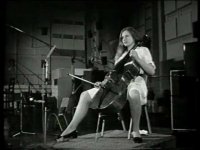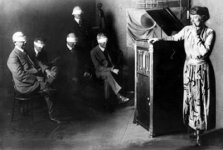What is to be gleaned from that you tube video other than cellos are sexy?
That be cautious of bs studies. Some of them are nothing more than snake oils.
Hi Keyser - yes it was definitely Koen. Slightly accentuated by the fact that the whole display area was raised on a platform of about 20cm and a lot of times I was on the lower level.Computer simulations only got us so far. Ultimately you just have to build and test it, especially the waveguide!
Not everyone seems to agree, and that's fine. I used to think differently too, but right now I'm aware that there already is a very solid scientific foundation when it comes to loudspeaker design. When we designed the 8c I really felt like we were standing on shoulders of giants. The design criteria for the 8c were very much in line with the teachings of for instance Floyd Toole.
I wonder if this is a good example of the concrete scientific foundation you mention: I found these plots on the Gearslutz forum where a user made a measurement of the 8c versus the Kii 3.
What I found even more shocking than the flatness of your published response plots, was the similarity between the measured response plots of these two speakers.

Of course there are some very clear parallels between the two (the edge radius and dome tweeter with waveguide, although theirs uses a smaller stepped radius and what appears to be a slightly larger diaphragm), there are also a whole host of significant differences - size of the box, size of the main woofer, width of baffle, woofer with a slight waveguide, location of woofer and tweeter on the baffle, and the approach to low end reinforcement in particular.

It's more or less line for line. The only discrepancy seems to be in the amplitude of the ripples. If I didn't know better I would suggest they had to be using the same drivers - I think 100% of people who saw that plot would say 'these speakers are using the same drivers'. Maybe the tweeter is the same but the woofers/passive radiators clearly aren't.
Green is the 8c. I think. I'd have to go back to the thread and check though.
Ahhh the NS10 mainly liked because they fit on top of a mixing desk. I agree with your point.
oooh, I don't know. I think the conclusion of studies (ok, at least one anyway) was that the NS-10 was chosen originally because of a low group delay, or a subjective appreciation of the effects of low group delay. And then at some point you had them because other studios did - common reference you can mix the same on (as long as you know their faults and have learned to mix on them to sound good on other speakers).
And apparently their response becomes more flat when placed on a mixing desk's meter bridge. .
The Yamaha NS10 Story |
PDF of a write-up of a study examining the NS-10.
I guess in double blind test...
It's been done.
Attachments
....the NS-10 was chosen originally because of a low group delay...
Wasn't the origin of that practice someone - I thought Nile Rodgers - mixing a #1 hit on a pair, tissue paper over tweeters ?
It is his first posting here, so there is no thread yet. But I am sure there will be more to follow.
Regards
Charles
How could you know? So there we go ...
DUT:
An externally hosted image should be here but it was not working when we last tested it.
Impulse response of the tweeter with only the naked blue DXT-Waveguide (red graph) vs. the one with the green-yellowish saladbowl-pseudosphere added around the waveguide (green graph):
An externally hosted image should be here but it was not working when we last tested it.
The impulse response with the spheroid is slightly more uniform than the one of the naked waveguide, especially @ 0.1ms.
Then the horizontal polar dispersions at -30° and 60° (T29)
Absolute values:
An externally hosted image should be here but it was not working when we last tested it.
Differences between off-axis and 0°:
An externally hosted image should be here but it was not working when we last tested it.
Everyone might draw their's own conclusions now. I have the impression of a slightly smoother off-axis-rsponse using the sphere, but it's basically a peanuts difference. Acutally I have chosen a 10"-diameter bowl for this first approach. Next iterative step will be the use of a slightly smaller bowl (7"-8" or so).
PS: There might be once a separate thread with a more in-depth presentation of this project.
When we listened to the recordings the snare drum and spoken voice were almost indistinguishable from live, but only if we made sure the sound level was close to the real level. With the cello it became immediately clear that, in the absence of reflections and reverberation, it is impossible to capture the true character of the instrument with a single microphone.
All this is to say that live vs. recorded is not really the ultimate test of a speaker, because it is very difficult to actually capture the sound of the live instrument. Also, the directivity of the speaker only in very specific situations will be similar to the directivity of the instrument. Nevertheless, I think people will be amazed at how close you can get with both spoken voice and the snare drum.
Did you have one ear blocked and were listening in mono when coming to the conclusion that the character of the cello couldn't be reproduced?
Perhaps what is "the character" of the cello is more defined by the differences in tone between each ear, the stereo / chorusing/ phasing differences and their changes in time. Also a cellist moves a lot when playing so again part of that character is the movement in stereo.
And of course the cello is a wide and large instrument all resonating and moving and causing all sorts of changing stereo comb filtering and phasing from its different parts and you can hear the movement of the player. It is not a point source as the speaker is.
You would need then a set up that mimicked a multiple mic set up and your listening position would need to be in some way the same in relation to both the microphones and the speakers.
A better test would be to experience the cello by listening with one ear only (and somehow reducing any stereo bone conduction too!) and listening to the speaker in the same way, both at the same position as the original single mic.
But yep, all this says to me that there are serious deficiencies in recording and replay *set-up* that prevent the recreation of a live event and so it is a poor test of a speaker. Better then to conciously enjoy listening to the sound that is hitting each microphone in a very studio-technique-concious way, imagining that your ear is at one point under the lid of the grand piano (when focusing on the piano) and at another time at the bridge of a guitar (when focusing on the guitar) but all the while enjoying the constructed whole as something new, just a sound creation.
Or listen to binaural recordings with good in-ear headphones
I have read of other tests where speakers have successfully recreated an orchestra but the difference is that the audience is far enough away from the speakers/orchestra where each player (each represented by a speaker) is in effect a point source. And you have the interaction of the concert hall in both.
Wasn't the origin of that practice someone - I thought Nile Rodgers - mixing a #1 hit on a pair, tissue paper over tweeters ?
Not according to the article I linked to - also covers the tissue paper thing.
thank god it´s 10db scaleWhat I found even more shocking than the flatness of your published response plots, was the similarity between the measured response plots of these two speakers.
Those measurements of Kii3 and 8c show mainly room reflections because of long IR gating. Obviousy both are relatively flat on-axis (eq'd?) and have quite similar DI. Propably measured relatively close, less than 2m?
Here another one -mostly room effects seen... Gearslutz Pro Audio Community - View Single Post - Kii Three-Have you heard them?

Here another one -mostly room effects seen... Gearslutz Pro Audio Community - View Single Post - Kii Three-Have you heard them?

Hi Keyser - yes it was definitely Koen. Slightly accentuated by the fact that the whole display area was raised on a platform of about 20cm and a lot of times I was on the lower level.
I wonder if this is a good example of the concrete scientific foundation you mention: I found these plots on the Gearslutz forum where a user made a measurement of the 8c versus the Kii 3.
What I found even more shocking than the flatness of your published response plots, was the similarity between the measured response plots of these two speakers.

Of course there are some very clear parallels between the two (the edge radius and dome tweeter with waveguide, although theirs uses a smaller stepped radius and what appears to be a slightly larger diaphragm), there are also a whole host of significant differences - size of the box, size of the main woofer, width of baffle, woofer with a slight waveguide, location of woofer and tweeter on the baffle, and the approach to low end reinforcement in particular.

It's more or less line for line. The only discrepancy seems to be in the amplitude of the ripples. If I didn't know better I would suggest they had to be using the same drivers - I think 100% of people who saw that plot would say 'these speakers are using the same drivers'. Maybe the tweeter is the same but the woofers/passive radiators clearly aren't.
Green is the 8c. I think. I'd have to go back to the thread and check though.
Buff, Gearslutz... But It Yourself Audio... Gear drug addicts... Zap!
What is to be gleaned from that you tube video other than cellos are sexy?
Yeah ... and that the "gear for gear sake" way of life sucks as an audiophile review at 6moons for the BoBos (*) on a rainy sunday...
F... them all!
YouTube
* Bourgeois & Bohemians
Last edited:
Yeah ... and that the "gear for gear sake" way of life sucks as an audiophile review at 6moons for the BoBos (*) on a rainy sunday...
F... them all!
Thank you - this is much clearer.In other words, comparing cardioid to monopole, fighting diffractions, con trolling directivity, or applying DRC will hardly give anybody an orgasm...
Except maybe to insanely perverted minds...
Last edited:
Thank you for the clarification.
Thanks to Jacqueline Du Pré, Daniel Barenboim, and people like them...

F... the gear sluts!
I just Googled the 8c and that thread appeared, that's all. Don't tar me with your slutty brush!
You part of what you google for..
- Home
- Loudspeakers
- Multi-Way
- What are some good example of baffle design to improve diffraction


